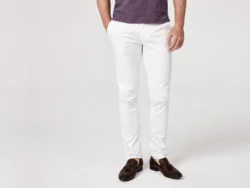Low-emission vehicles. Biodegradable packaging. Sustainably-sourced supplies. Green fashion. Buyers are calling brands to be more responsive to the planet, and don’t want to hear that it’s too hard.
And with worldwide governments starting initiatives to guide organisations and individuals on how to achieve these goals, brands have no excuse to neglect these requirements any longer. For many people, the impact, certain parts of their lives have on the environment is obvious (using plastic items, flying overseas, driving fuel-powered cars). But when it comes to the clothes they’re wearing, the impact they have on the planet is less clear. Surprisingly (for some) the fashion industry generates 10% of the overall carbon emissions and is the second-largest consumer of water, worldwide. Even if people try to be more conscious of the way they dress, clothing production has doubled since the beginning of the new millennium. Before 2000,in Europe, fashion designers launched two collections annually, but starting with 2011, they are offering five collections. And this is only the average number of collections European brands launch, but some companies like Zara and H&M bring on the market even 24 collections per year.
And because people want to keep up with the latest trends, they end up putting a lot of clothing in the dumpster because they need free space for new items. At the end of each year, 85% of the textiles created in 12 months get to landfills. The amount is more than enough to fill the Sydney harbour.
The fashion industry recognises the harmful impact it has for the environment, and it decided to try to find its way back to an era when it didn’t make the planet a dangerous place.
The European fashion industry has a green recovery plan The Policy Hub, an initiative started by the Sustainable Apparel Coalition, the Federation of the European Sporting Goods Industry and the Global Fashion Agenda, has created a green recovery plan for the fashion industry residing in Europe. They presented the proposal to the European authorities who approved it and issued a plan that outlines the seven principal regulations apparel providers must follow from now on, to direct the industry towards a greener era. The seven guidelines are split into short and long-term measures that should trigger an economic recovery and the development of a circular economy.
Several famous brands, including H&M, Burberry, Inditex and Stella McCartney, have already signed the plan and are making efforts to move towards the circular economy the Policy Hub proposed. The fashion companies join a number of organisations from all industries that support initiatives that drive circular economy solutions for sectors like fashion, food and plastics. Ellen MacArthur Foundation created a pact that sets goals for the fashion industry.Manufacturers should ensure they use renewable materials that can be reintroduced in the process, once the buyer no longer uses the product.
Adidas partners with Allbirds to create a line of low carbon impact shoes
Adidas is one of the people’s favourites when it comes to athletic shoes, and the industry looks to them as to a role model when it comes to initiatives. To lead the footwear industry towards a new stage, Adidas joint efforts with the sustainable show provider Allbirds to create a sports performance shoe with the lowest carbon footprint ever recorded.
Quantis International has released a study in 2018 that reveals that the footwear industry generated 700 metric tons of carbon dioxide annually. The two partners want to do more than just launch a line of shoes that has a low carbon footprint; they also want to innovate the manufacturing and supply chain processes to use more renewable resources. Tim Brown, the co-CEO of Allbirds, stated that the mission is bigger than their partnership, and they want to show the other brands the change starts with them. All fashion brands are in a race they have to run together to save the planet. Together with James Carnes, the vice-president of Adidas brand strategy, they want the initiative to be the catalyst to a movement that triggers improvement in the fashion sector. The shoemakers extend their measures to the waste management strategies they use to dispose of the scrap produced during manufacturing. They adopted green policies that imply the use of Mil-tek waste compactors to recycle their garbage.
Dim Mak announced a collaboration with Candiani to launch a sustainable line of denim
For those who have never heard of Dim Mak, they should know DJ Steve Aoki founded it, and it offers unique but wearable pieces of clothing. Dim Mak has recently started a collaboration with Candiani denim to launch the first collaborative pair of jeans made from sustainable fabrics and with clean manufacturing methods. The Candiani Denim Mill manufactured the fabrics for the Dim Mak x Candiani EC-01 pair of jeans, wholly made in Los Angeles. It’s a limited-edition pair of jeans, hand-painted by Steve Aoki and his Dim Mak artisans.
The straight-fit pairs of jeans are made from denim produced from recycled cotton at the Candiani Mill. Even if most distressed jeans would require repetitive wash, the pair from Dim Mak needed minimal procedures to achieve the vintage look because the producers used laser technology to burn the fabric’s surface and obtain a distressed appearance.
When they designed the process for creating this exclusive pair of jeans, they made sure it allows for savings in terms of fabrics, chemicals, water and energy, compared to traditional denim items. A Candiani representative highlighted that they didn’t want to cede quality for sustainability, so they made sure they maintain the aesthetics, durability and performance Dim Mak has provided to its clients since its launch.
At the end of the project, the reports show that the jeans required the use of only 31 litres of water, compared to 2,755 used for a standard pair. Also, Candiani used a low amount of chemicals, less than 0.2 kg, instead of 0.8, most denim producers use.
The jeans still look like one-of-a-kind pieces, embellished with manga aesthetics, but their impact on the environment is considerably low.







